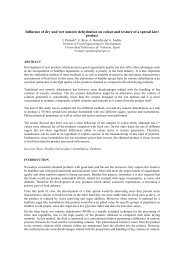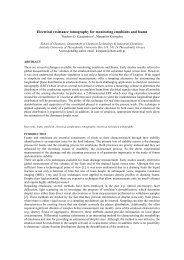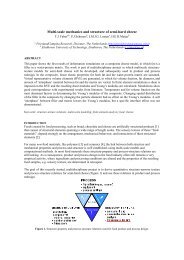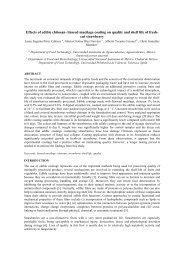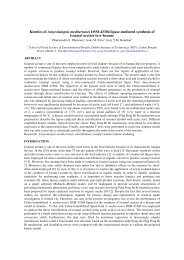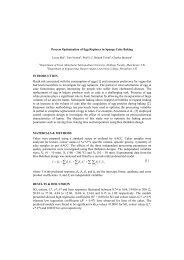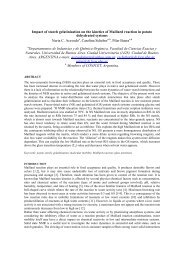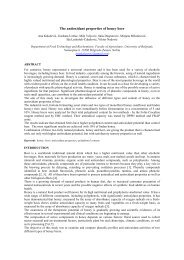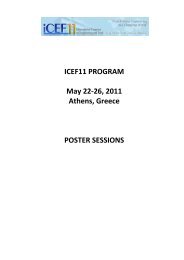Osmo-dehydration of fruits
Osmo-dehydration of fruits
Osmo-dehydration of fruits
Create successful ePaper yourself
Turn your PDF publications into a flip-book with our unique Google optimized e-Paper software.
<strong>Osmo</strong>-Dehydration <strong>of</strong> Fruits: a thermodynamic approach via Knudsen<br />
Thermogravimetry<br />
Dimitrios Fessas, Marco Signorelli, Alberto Schiraldi<br />
DISTAM, Università di MilanoVia Celoria 2, 20133 Milano, Italy (dimitrios.fessas@unimi.it)<br />
ABSTRACT<br />
The osmo-<strong>dehydration</strong> <strong>of</strong> a fruit pulp can be described with a thermodynamic model that takes into account<br />
the heterogeneity <strong>of</strong> the system. The experimental data are those relevant to the isothermal desorption trends<br />
across the swept RH range for the original (peeled) and partially osmo-dehydrated fruit pulp, and the<br />
hypertonic sugar syrup used. These trend allow evaluation <strong>of</strong> the mass <strong>of</strong> intra- and extra-cellular phases <strong>of</strong><br />
the system at any given RH. The mass change <strong>of</strong> the intra- cellular aqueous phase allows a rough evaluation<br />
<strong>of</strong> the shrinkage that the fruit cells undergo and the correlation between shrinkage and RH, which may be<br />
applied to any kind <strong>of</strong> <strong>dehydration</strong> treatment, provided it does not affect the cell walls.<br />
Keywords: osmo-dehydratio, Knudse thermo-gravimetry; thermodynamics<br />
INTRODUCTION<br />
Water in <strong>fruits</strong> and vegetables has a thermodynamic activity, a W , close to unity, which makes easy their<br />
degradation. This is why a previous <strong>dehydration</strong> is demanded to avoid non enzymatic browning and<br />
preservation <strong>of</strong> bioactive components (mainly vitamins and aromatic compounds).<br />
In osmo-<strong>dehydration</strong> the fruit is poured into a hypertonic solution <strong>of</strong> simple sugars and the intracellular<br />
moisture is drained out because <strong>of</strong> the sugar concentration gradient. The final product is still rather s<strong>of</strong>t and<br />
microbiologically unstable, as part <strong>of</strong> its moisture is retained. A final mild heat treatment (e.g., low<br />
temperature convection drying, freeze drying etc.) enhances the stability.<br />
It must be noticed that fruit cell walls are not actually semipermeable. Some fruit solutes (sugars, organic<br />
acids, minerals, salts, etc.) are therefore leached into the hypertonic solution while some sugar <strong>of</strong> this can<br />
migrate into the intra-cellular spaces (usually, even simple sugars are not able to trespass the cell walls) and<br />
the whole system shrinks as the fruit cells change size and shape. Dehydration extent and composition <strong>of</strong> the<br />
hypertonic syrup can affect the quality <strong>of</strong> the final product [1, 2].<br />
In order to assess the best operating practice models for the water migration and location during the process<br />
have been so far searched. A number <strong>of</strong> models [3,4] were proposed, where, in order to exclude any change<br />
<strong>of</strong> the hypertonic syrup during the process, its mass was supposed to be much larger than the fruit poured in.<br />
All these models assume a fickian behaviour for the diffusion, although they can substantially differ from one<br />
another for the number <strong>of</strong> the fitting equations and adjustable parameters. Unfortunately, they do not<br />
satisfactorily represent the actual system and the real operating conditions for a number <strong>of</strong> reasons: (i) a<br />
substantial change <strong>of</strong> the hypertonic syrup the mass <strong>of</strong> which actually does not exceed the 4:1 ratio versus<br />
that <strong>of</strong> the fruit; (ii) the sample is referred to as a continuum with a given macroscopic geometry that<br />
undergoes shrinkage as a whole; (iii) no general fundament is assumed that may be directly applied to any<br />
kind <strong>of</strong> fruit or vegetable (kind <strong>of</strong> cultivar, age after harvest, storing conditions, etc., are presented as the<br />
reason for the model limit).<br />
A basic statement is indeed lacking in all these models, namely, that the moisture content <strong>of</strong> biological<br />
materials is partitioned in different fractions and states, depending on the kind <strong>of</strong> tissue compartment and the<br />
solutes therein hosted. Because <strong>of</strong> the presence <strong>of</strong> extracellular biopolymers, cell membranes and other<br />
physical barriers, water molecules <strong>of</strong> the various moisture fractions have different mobility, as evidenced by<br />
means <strong>of</strong> NMR relaxometry [5], and are perpetually involved in exchanges between different states.<br />
The present work proposes a thermodynamic approach that defines boundary conditions that must be anyway<br />
obeyed, no matter the kind <strong>of</strong> fruit to be dehydrated and the hypertonic medium used in the process. It makes<br />
use <strong>of</strong> the aW changes both in fruit pulp and hypertonic syrup during a real osmo-<strong>dehydration</strong> process.<br />
To this aim, the isothermal desorption trends <strong>of</strong>: (i) non-treated fruit, (ii) syrup used for the osmo<strong>dehydration</strong>,<br />
(iii) a partially osmo-dehydrate fruit, have to be determined. The experimental method proposed<br />
is the Knudsen Thermogravimetry, which was so far exploited to determine the desorption isotherms <strong>of</strong>
aqueous solutions <strong>of</strong> salts and sugars, and food systems, like dough <strong>of</strong> various cereal flours [6,7]. The kind <strong>of</strong><br />
equipment used, namely, a TG-DSC combined instrument, allows extention <strong>of</strong> the investigation to various<br />
temperatures.<br />
MATERIALS & METHODS<br />
The Knudsen TG, designed by Schiraldi and Fessas [6], allows the direct determination <strong>of</strong> water activity. The<br />
thermo-balance cells are replaced with Knudsen cells, namely closed cells the cover <strong>of</strong> which has a 20 m<br />
orifice through which water molecules are pumped out under high dynamic vacuum (pext ≈ 0). In isothermal<br />
conditions the flux <strong>of</strong> water through the orifice, J, is proportional to the water partial pressure, p W , within the<br />
cell,<br />
dmW<br />
J = ∝ ( pW<br />
− pext<br />
) ≈ K ⋅ pW<br />
(1)<br />
dt<br />
where the constant K depends on the temperature and the size <strong>of</strong> the orifice and the flux J corresponds to the<br />
record <strong>of</strong> the time derivative <strong>of</strong> the thermo-gravimetric (DTG) trace.<br />
A separate experiment (at the same temperature and vacuum conditions) with a pure water sample produces a<br />
flux J* = K p W *, where p W * is the vapour pressure <strong>of</strong> pure water. The p W /p W * ratio is a good approximation<br />
for the value <strong>of</strong> water activity, a W , (or relative humidity, RH) <strong>of</strong> the sample considered. Because <strong>of</strong> the<br />
sample <strong>dehydration</strong> that takes place during the KTG run, the p W /p W * ratio decreases, while the mass drop is<br />
simultaneously recorded: this allows the direct evaluation <strong>of</strong> the residual sample moisture content versus RH,<br />
namely, the desorption isotherm.<br />
A single run therefore allows to draw the whole desorption trend, plotted in the plane (m W /m dm , RH), where<br />
the subscripts “W” and “dm” stand for water and dry matter, respectively, with reference to the trace <strong>of</strong> pure<br />
water recorded immediately before [6].<br />
These desorption trends are to be considered within the RH range actually experienced during an osmo<strong>dehydration</strong><br />
process, i.e. RH ≥ 0.8.<br />
The instrument used was a SETARAM TG-DSC111, Lyon, France, which allowed the simultaneous output<br />
<strong>of</strong> TG trace, namely mass loss-vs-time, its time derivative, DTG, and the relevant thermal effect. Thanks to<br />
such a coupling, the mass loss can be reliably attributed to the release <strong>of</strong> water if the mass-loss-rate/heat flux<br />
ratio has a value <strong>of</strong> about 2.2 J g-1, namely, the vaporization enthalpy <strong>of</strong> water [6], which is expected to hold<br />
also for water rich systems, like salt and sugar solutions, vegetables and <strong>fruits</strong>.<br />
Fuji cultivar apples, peeled and cut into spheres (d about 1.5 cm), were osmo-dehydrated at room temperature<br />
(~25°C) with three different sugar syrups <strong>of</strong> given water activity (a W = 0.89). The hypertonic syrup was<br />
continuously re-circulated through a peristaltic pump and the fruit-syrup mass ratio was kept at 1/8 (w/w);<br />
composition and water activity <strong>of</strong> the syrup underwent some detectable changes. Different treatment times<br />
were exploited (up to 6 h) in order to obtain samples at different <strong>dehydration</strong> levels. After the osmotic<br />
treatment, the samples were carefully and rapidly washed with cold water (details are reported in [8]). 40 mg<br />
mass samples were used for the KTG investigations.<br />
RESULTS & DISCUSSION<br />
In a osmo-<strong>dehydration</strong> process the dry matter <strong>of</strong> the sample increases, the RH <strong>of</strong> the fruit decreases and that<br />
<strong>of</strong> the hypertonic syrup increases, since the removal <strong>of</strong> water from the fruit is more than counterbalanced by<br />
the migration <strong>of</strong> sugars from the syrup toward the apple pulp. The process ends (after about 4 hour, in the<br />
present case) when fruit and syrup attain the same RH value.<br />
Since the intracellular water is sucked out <strong>of</strong> the fruit cells and displaced toward the intercellular regions and<br />
the surrounding medium, the RH <strong>of</strong> this is indeed a little higher at the end <strong>of</strong> the treatment.<br />
The starting samples <strong>of</strong> a Knudsen experiment must be in a steady state, i.e., with no neat water displacement<br />
between fruit compartments. During the isothermal <strong>dehydration</strong> the water fraction with the easiest access to<br />
the head space <strong>of</strong> the Knudsen cell determines the actual vapor pressure and therefore the RH detected. This<br />
means that RH gradients are soon formed between different fruit compartments. The relevant Knudsen trend<br />
therefore reflects quasi equilibrium states only when the effusion through the cell orifice is as slow as the<br />
displacement <strong>of</strong> water from one compartment to another.<br />
The desorption isotherm <strong>of</strong> non-treat fruit deals with a system the dry matter <strong>of</strong> which does not change. The<br />
release <strong>of</strong> water from the fruit is in this case limited by the diffusion <strong>of</strong> water through the cell walls. The fact
that partially heat-dehydrated apple pulp shows a Knudsen desorption trend perfectly overlapped to that<br />
obtained from the original non treated sample (Figure 1) indicates that the Knudsen desorption goes through<br />
the states that are actually met during a heat drying process.<br />
The desorption isotherm <strong>of</strong> a partially osmo-dehydrated fruit instead reflects the removal <strong>of</strong> water from the<br />
intercellular regions where it is more mobile: the desorption trend therefore concerns the partially diluted<br />
(because <strong>of</strong> the water sucked from the apple cells) syrup that remains entrapped in the fruit pulp. If a partially<br />
osmo-dehydrated fruit is further dried with a mild heat treatment, the removal <strong>of</strong> water still deals with the<br />
intercellular moisture. The desorption isotherm <strong>of</strong> such a sample is indeed overlapped to that obtained from a<br />
sample that did not undergo the further heat drying (Figure 1).<br />
Figure 1. Desorption isotherms drawn from KTG traces. Apple pulp samples: non treated, partially heat<br />
dried, partially osmo-dehydrated and heat dried after a partial osmo-<strong>dehydration</strong>.<br />
The desorption trend <strong>of</strong> a partially osmo-dehydrated fruit is shifted toward larger RH with respect to those <strong>of</strong><br />
the non-treated fruit and the hypertonic syrup (Figure 2). It has to be noticed that any fruit pulp is are multiphase<br />
system. In a rough approximation, it may referred to as a two phase system, namely, the intra- and the<br />
extra-cellular aqueous regions. A true thermodynamic equilibrium would imply that each compound that can<br />
be exchanged between these phase may attain the same thermodynamic activity in either phase. The partially<br />
osmo-dehydrated samples considered for the isothermal Knudsen desorption had been removed from the<br />
hypertonic syrup and let at rest for some hours to allow any neat displacement <strong>of</strong> water and sugars between<br />
phases to vanish. The composition <strong>of</strong> either phase therefore reflects the balance <strong>of</strong> the relevant chemical<br />
potentials and the amount <strong>of</strong> each phase can be evaluated with the simple lever rule.<br />
This means that the desorption trends recorded for the non-treated fruit pulp and the sugar syrup reflect the<br />
composition <strong>of</strong> the intra and extra-cellular phase, respectively (Figure 2). Any partial <strong>dehydration</strong> state must<br />
therefore remain between these trends (Figures 2) and, at any given RH, the mass <strong>of</strong> intra- and extra-cellular<br />
phase <strong>of</strong> the partially osmo-dehydrated sample can be easily evaluated [8].<br />
The decrease <strong>of</strong> the intracellular water produces shrinkage <strong>of</strong> the fruit cells, namely, a reduction <strong>of</strong> their<br />
volume. The volume drop is mainly related to the release <strong>of</strong> water: therefore a rough evaluation <strong>of</strong> such cell<br />
shrinkage may be:<br />
VW<br />
,0<br />
−VW<br />
shrinkage ≈ (2)<br />
V<br />
W ,0
Figure 2. Knudsen desorption isotherms collected from non- treated, partially (one hour treatment) osmodehydrated<br />
apple pulp, and the hypertonic sugar syrup used in the process. mW and mdm stand for water and<br />
dry matter mass, respectively.<br />
Since these quantities can be directly correlated to the RH through the relevant desorption isotherm, one may<br />
describe the shrinkage extent versus RH (Figure 3), which therefore applies to every partial <strong>dehydration</strong><br />
level, no matter the way it has been achieved (through osmo-<strong>dehydration</strong>, or heat drying, or combined<br />
treatment).<br />
Figure 3. Shrinkage <strong>of</strong> the cells <strong>of</strong> apple pulp evaluated according to equation 2 (see text). Data from the<br />
Knudsen desorption trend <strong>of</strong> non- treated samples.
CONCLUSION<br />
The osmo-<strong>dehydration</strong> <strong>of</strong> a fruit pulp can be described with a thermodynamic model that takes into account<br />
the heterogeneity <strong>of</strong> the system. The experimental data are those relevant to the isothermal desorption trends<br />
across the swept RH range for the original (peeled) and partially osmo-dehydrated fruit pulp, and the<br />
hypertonic sugar syrup used. These trend allow evaluation <strong>of</strong> the mass <strong>of</strong> intra- and extra-cellular phases <strong>of</strong><br />
the system at any given RH. The mass change <strong>of</strong> the intra- cellular aqueous phase allows a rough evaluation<br />
<strong>of</strong> the shrinkage that the fruit cells undergo and the correlation between shrinkage and RH, which may be<br />
applied to any kind <strong>of</strong> <strong>dehydration</strong> treatment, provided it does not affect the cell walls.<br />
REFERENCES<br />
[1] Torreggiani D. and Bertolo G. J. Food Eng. 2001; 49: 247-.<br />
[2] Lewicki PP., Le H. Vu and Pomaranska-Laznka W. J. Food Eng. 2002 ; 54: 141.<br />
[3] N. M. Panagiotou, V. T. Karathanos, Z.B. Maroulis. Int. J. Food Sci. Technol. 1998, 33, 267.<br />
[4] . L. Seguı´, P.J. Fito, A. Albors, P. Fito, J. Food Eng. 2006, 77, 179.<br />
[5] Hills BP. Magnetic Resonance Imaging in Food Science, John Wiley &Sons, Inc. Publ. New York; 1998<br />
[6] Schiraldi, A. and Fessas, D. , J. Therm. Anal. Cal. 2003, 71, 221.<br />
[7] Fessas, D. and Schiraldi, A. Food Chemistry 2004,90, 61.<br />
[8] Pani P., Schiraldi A., Signorelli M. and Fessas D., Food Biophysics, 2010,5 (3) 177.



